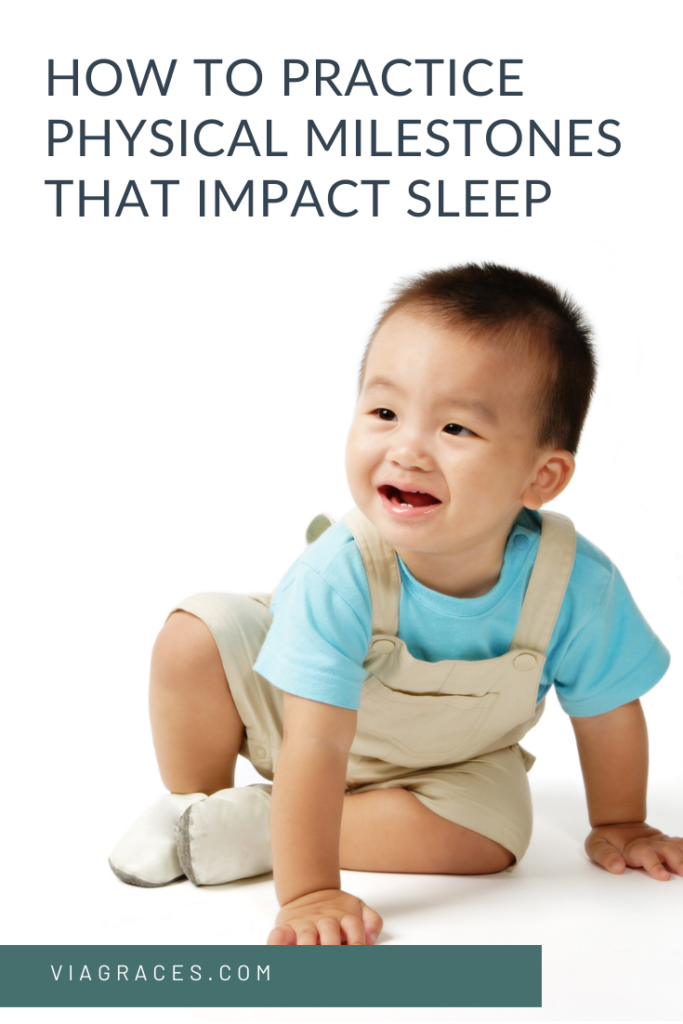Sleep regressions…yes, they’re a thing!
But as I’ve mentioned before, rather than being connected to specific ages, sleep regressions are most often associated with our babies and toddlers reaching new developmental milestones, such as rolling, crawling, walking, and talking.
Our little ones are ready to practice and they often do so when they should be sleeping! It might take your little one extra long to fall asleep at night or for naps, and you may even see a spike in night wakings. And it can be so frustrating!
As a sleep consultant, my “answer” is most commonly to remain consistent with your approach to sleep, and practice practice practice that new skill during the day.
But how to actually practice the gross motor skills, in particular, is the hard part!
That’s why I’m excited to have Stacy Menz, a Pediatric Physical Therapist, on the blog to teach us more. Enjoy!
You have worked so hard to get your little one to sleep and all of a sudden they learn how to roll. You work through that and then they learn how to sit. You get past that stage and then they learn how to stand.
While you are excited about these motor skill acquisitions, it isn’t fun when they interrupt your little one’s sleep that you worked so hard to achieve!

Why do motor skill acquisitions sometimes affect our little one’s sleep?
Well, it’s because now that babies have this new skill, they like to use it! Unfortunately, they may know how to roll in one direction but not how to get back to their comfortable sleeping position. Same goes with sitting and standing up.
So what can you do to help?
You can work on these skills while they are awake! That seems so simple, but spending about 20 minutes of purposeful play on the new skill each day will make a big difference in your little one’s sleep as they go through these milestones.
Rolling
Let’s start with rolling. Rolling is generally the first skill that has the potential to alter sleep. It is also when you need to stop using the swaddle, if you have been swaddling your baby.
Belly to Back
To practice rolling from belly to back there are a few main things that need to happen.
Your little one needs to be spending time on their belly when awake. I know you are all probably tired of hearing about tummy time, but it will help them master skills like rolling and crawling and moving and grooving!
While on their belly, you want to work on your baby pushing up on their arms. Ideally they will be able to keep their arms under their shoulders, because the wider their arms are, the harder it is to complete the roll.
In order to work on this skill, I recommend having toys at various heights around your child. Utilize the activity arches, activity cubes, toys on a step stool, etc. You want your little one to start being interested in what is up higher!
Next is weight shifting. This happens as your little one begins to reach for toys. Ideally, if you want them to roll over their right side, you will hold a toy or something interesting up and to the left (near their arm) so that they will turn their head and lift their arm.
This causes them to weight shift to the left, and from there they roll over! You can give them a little assist at their hips, if you want.
Here is a video that breaks it down simply.
Back to Belly
Rolling from back to belly is the next rolling skill you can work on.
For this skill you want to work on your little one’s core strength. Some ways to do that are to encourage hand and foot play, or to have the activity center positioned so that they can try to kick at toys!
You also want to work on reaching, specifically reaching across the body.
Let’s say you are trying to get your baby to roll over their left side. I like to find a really motivating toy and start with it over their right arm so that they attempt to reach for it.
Once they are engaged and trying, slowly move it toward the left. At the same time you can gently help at the hip.
Depending on the baby’s age, you may get a little resistance when they get to side-lying. If that happens, I do two different things:
- I spend more time with them playing in a side-lying position.
- Two, I will spend some time just quickly taking them through the roll myself. I will start like I mentioned above and then I will finish the roll for them making sure there is something really motivating and fun for them once they are on their belly. Eventually they will not resist the roll and help even more.
The other thing that can happen is that their left arm (or whatever arm they are rolling over) gets stuck.
If this happens, I like to start with tickling the baby a little under that armpit to get them to work on actively bringing the arm out, but if that isn’t working, I will help them be successful.
Here is a video that shows ways to help with this skill.
Here is a video that has a fun way to work on rolling in both directions. It gives your little one a boost to help them complete the roll, and all you need is an oversized pillow!
Sitting
The next skill that may have an impact on your little one’s sleep is getting into sitting. They get up and then they don’t know how to lie back down.
So how do you work on this with them?
First, try not to have all of your baby’s toys directly in front of them or within arms reach when you are playing with them in sitting. In fact, I recommend starting to work on this before they become a proficient sitter, because once they know how to sit they will be less likely to want to do something that feels unstable to them.
So now that you’ve moved their toys, what do you do?
Similar with trying to get them to reach across their body for rolling, start with a toy slightly out to the side so that they think it is within reaching distance. As they start to reach for it, slowly move the toy out to the side more.
In the beginning, they will have an uncontrolled lowering down to the ground (it may look more like a fall), but cheer them on as if they just did the greatest thing ever.
If they are really resistant you can help them do it.
As you move the toy to the side, you can guide them down until they are on their belly and playing with the toy. I like to do out to the side because it helps them learn rotation at the trunk and the hips which will help decrease the likelihood of them relying on w-sitting.
Here is a video that talks about this transition.
Another way to help is to work on side-sitting. This position helps them to learn to transition in and out of sitting easily and has the added benefit of working on getting their core stronger!
Check out this video for working on this sitting position.
Standing
Lastly is standing. The key here is to get your little one back down to the sitting position (or out of the standing position) and then they can use the skills learned above to get back to lying down.
Babies generally don’t know how to get back down because it is a skill that involves control, and until they practice it they don’t know they can do it.
As with almost any skill that involves control, there will be uncontrolled (or plopping) that happens. This is okay! It allows babies to take in the feedback and make the adjustments needed to develop the control.
So when your little one is awake and standing, work on having them reach down for toys. Place them on stools or hold them off the ground to make it easier at first. Just like above, you are making it so they are enticed and willing to attempt the movement.
As they get better about bending to reach for a toy, you can slowly lower it until it is all the way to the ground.
If your baby needs a little extra help with bending their knees, you can sit behind them and help them practice bending their knees to sit in your lap.
Between these two ways of practicing, your baby will develop more and more control so they can get out of standing like a pro!
Here is a video that looks at this skill.
When your child gets stuck…
As kids learn these skills and get ‘stuck’ in a new position in bed, you have a few options. You can quietly go in and help them move back into a lying position and then continue to repeat as they keep rolling or sitting or standing.
What I did (and many may not agree with this) is once I helped my son once or twice during a sleep period, I left him in the position because it had the potential of becoming a game for him; he would learn that one way to get me back in was to sit up, for example.
Additional Resources
If you are looking for additional resources, check out our video playlists on YouTube!
We also have a round-up of all of our Developmental Milestone Blogs which we regularly add to.
Lastly, we have Gross Motor Programs geared toward specific skills. They are self-paced or can include virtual check-ins. So check them out!
About the Author

Stacy M. Menz is the owner and founder of Starfish Therapies, a pediatric Physical Therapy company, and she’s the mom to an active toddler! She is passionate about helping kids and their families, and teaching other therapists. She is active in her professional organizations and regularly does adjunct teaching at Doctorate of Physical Therapy programs in their pediatric class. If you want to see more, check out her Instagram, Facebook, or YouTube channel. Starfish Therapies also has great products in their shop!
